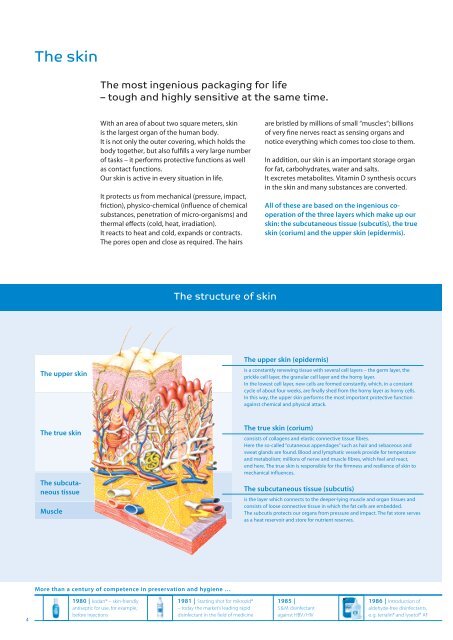Medical skin care - Schülke & Mayr
Medical skin care - Schülke & Mayr
Medical skin care - Schülke & Mayr
You also want an ePaper? Increase the reach of your titles
YUMPU automatically turns print PDFs into web optimized ePapers that Google loves.
4<br />
The <strong>skin</strong><br />
The upper <strong>skin</strong><br />
The true <strong>skin</strong><br />
The subcutaneous<br />
tissue<br />
Muscle<br />
The most ingenious packaging for life<br />
– tough and highly sensitive at the same time.<br />
With an area of about two square meters, <strong>skin</strong><br />
is the largest organ of the human body.<br />
It is not only the outer covering, which holds the<br />
body together, but also fulfills a very large number<br />
of tasks – it performs protective functions as well<br />
as contact functions.<br />
Our <strong>skin</strong> is active in every situation in life.<br />
It protects us from mechanical (pressure, impact,<br />
friction), physico-chemical (influence of chemical<br />
substances, penetration of micro-organisms) and<br />
thermal effects (cold, heat, irradiation).<br />
It reacts to heat and cold, expands or contracts.<br />
The pores open and close as required. The hairs<br />
More than a century of competence in preservation and hygiene …<br />
1980 | kodan® – <strong>skin</strong>-friendly<br />
antiseptic for use, for example,<br />
before injections<br />
The structure of <strong>skin</strong><br />
1981 | Starting shot for mikrozid®<br />
– today the market’s leading rapid<br />
disinfectant in the field of medicine<br />
are bristled by millions of small “muscles“; billions<br />
of very fine nerves react as sensing organs and<br />
notice everything which comes too close to them.<br />
In addition, our <strong>skin</strong> is an important storage organ<br />
for fat, carbohydrates, water and salts.<br />
It excretes metabolites. Vitamin D synthesis occurs<br />
in the <strong>skin</strong> and many substances are converted.<br />
All of these are based on the ingenious cooperation<br />
of the three layers which make up our<br />
<strong>skin</strong>: the subcutaneous tissue (subcutis), the true<br />
<strong>skin</strong> (corium) and the upper <strong>skin</strong> (epidermis).<br />
The upper <strong>skin</strong> (epidermis)<br />
is a constantly renewing tissue with several cell layers – the germ layer, the<br />
prickle cell layer, the granular cell layer and the horny layer.<br />
In the lowest cell layer, new cells are formed constantly, which, in a constant<br />
cycle of about four weeks, are finally shed from the horny layer as horny cells.<br />
In this way, the upper <strong>skin</strong> performs the most important protective function<br />
against chemical and physical attack.<br />
The true <strong>skin</strong> (corium)<br />
consists of collagens and elastic connective tissue fibres.<br />
Here the so-called “cutaneous appendages” such as hair and sebaceous and<br />
sweat glands are found. Blood and lymphatic vessels provide for temperature<br />
and metabolism; millions of nerve and muscle fibres, which feel and react,<br />
end here. The true <strong>skin</strong> is responsible for the firmness and resilience of <strong>skin</strong> to<br />
mechanical influences.<br />
The subcutaneous tissue (subcutis)<br />
is the layer which connects to the deeper-lying muscle and organ tissues and<br />
consists of loose connective tissue in which the fat cells are embedded.<br />
The subcutis protects our organs from pressure and impact. The fat store serves<br />
as a heat reservoir and store for nutrient reserves.<br />
1985 |<br />
S & M disinfectant<br />
against HBV / HIV<br />
1986 | Introduction of<br />
aldehyde-free disinfectants,<br />
e. g. terralin® and lysetol® AF

















